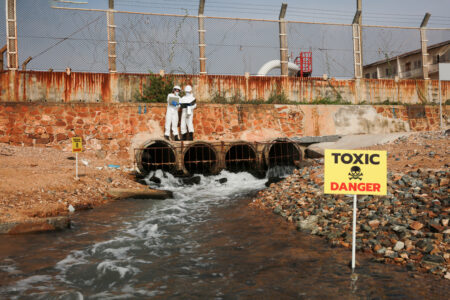
Share On Social!
UPDATE: August 8, 2019
Six states filed lawsuits against the EPA over chlorpyrifos—a pesticide that is linked to numerous and life-threatening effects—yesterday.
Researchers have connected this form of chemical exposure to the development of cognitive, physical complications, according to The Hill. The states, which include California (39.3% Latino), New York (19.2%), Massachusetts (12.3%), Washington (12.9%), Maryland (10.4%), and Vermont (2%), say the chemical is too dangerous to be on the market.
“Parents shouldn’t have to question whether everyday fruits and vegetables will poison their children,” California Attorney General Becerra said in a press release. “The EPA is egregiously sacrificing our children’s health by refusing to make a determination on this dangerous pesticide.”
The EPA has yet to comment on the lawsuit directly, but the agency did acknowledge that the chemical is not safe. Currently, their only plan to address the problem is to review data and information concerning chlorpyrifos through 2022
States officials and activists pushed back against that extended timeline, hence the suit. They say the EPA must address this issue sooner rather than later.
“A nerve agent pesticide that poisons workers and damages children’s developing brain has no place near our fruits and vegetables,” Ramon Ramirez, president of Pineros y Campesinos Unidos del Noroeste, said in a statement. “We look forward to seeing the courts do what EPA refuses to do, protect workers and children with a chlorpyrifos ban.”
Editor’s Note: This article was originally published on July 24, 2019, prior to the lawsuit. The initial post is included below.
Last week, the EPA announced it would not act in banning a toxic chemical that studies show can cause brain damage in children.
Chlorpyrifos, which is now mainly used as a pesticide, was banned from residential use in 2001. However, the agency stated the available data was “not sufficiently valid, complete, or reliable” enough to warrant a ban.
Studies conversely illustrate links between chlorpyrifos exposure and long-term impacts on childhood brain development as well as function, according to the Scientific American.
“By allowing chlorpyrifos to stay in our fruits and vegetables, Trump’s EPA is breaking the law and neglecting the overwhelming scientific evidence that this pesticide harms children’s brains,” Patti Goldman, a lawyer for Earthjustice, said in a statement.
The Decision and its Potential Risks
This conclusion comes from the agency’s rejection of a petition, submitted by a coalition of health and environmental groups, to ban the substance outright.
 That decision has received harsh criticism but is considered to be a win for chemical corporations and farmers, who produce and use the substance respectively, according to the New York Times.
That decision has received harsh criticism but is considered to be a win for chemical corporations and farmers, who produce and use the substance respectively, according to the New York Times.
The EPA stated that prior rulings, such as the Obama administration’s ban of chlorpyrifos on numerous crops, were based on public health studies, not animal testing. Still, various studies have shown that humans do face life-altering harm when exposed to the chemical.
A 2012 study, conducted at the Mailman School of Public Health at Columbia University, illustrates those effects.
“Our findings indicate that prenatal [chlorpyrifos] exposure, at levels observed with routine (nonoccupational) use and below the threshold for any signs of acute exposure, has a measurable effect on brain structure,” the researchers state. “We found significant abnormalities in morphological measures of the cerebral surface associated with higher prenatal [chlorpyrifos] exposure, after adjusting for possible confounders.”
Impacts Facing the Latino Community
Latinos face harmful chemical exposure on the job and at home at high rates.
In May, California state legislators took steps to ban chlorpyrifos “in a move to protect workers, public health, and the environment.”
Those with knowledge of the chemical’s potential risks said this move was a step toward better chemical regulation and legislation.
 “California’s action to cancel the registration of chlorpyrifos is needed to prevent the significant harm this pesticide causes children, farmworkers, and vulnerable communities,” said California Environmental Protection Agency Secretary, Jared Blumenfeld, in a statement. “This action also represents a historic opportunity for California to develop a new framework for alternative pest management practices.”
“California’s action to cancel the registration of chlorpyrifos is needed to prevent the significant harm this pesticide causes children, farmworkers, and vulnerable communities,” said California Environmental Protection Agency Secretary, Jared Blumenfeld, in a statement. “This action also represents a historic opportunity for California to develop a new framework for alternative pest management practices.”
Many Latinos could already face chlorpyrifos, considering they make up a large population of agricultural workers.
Moreover, many of these workers are not documented citizens, according to the U.S. Department of Agriculture. This means these laborers could also face a lack of healthcare access if they face harmful effects from chlorpyrifos exposure.
Worse, this demographic already faces other toxic exposure in the air, such as pollution from power plants and cars, at higher levels than their racial peers.
While there is no further action to take concerning a chlorpyrifos ban currently, other issues still need a response from Latinos and all Americans.
Send an email to the USGS today, urging a reversal on their decision to project long-term climate change impacts no longer.
URGE FOR CLIMATE SCIENCE!
Editor’s Note: This article is part of a collaboration between Salud America! and the Hoffman Toxicant-Induced Loss of Tolerance (TILT) program at UT Health- San Antonio. To find out if you are TILTed due to exposure to everyday foods, chemicals, or drugs, take a self-assessment or learn more about TILT.
By The Numbers
1
Quick Survey
Can help you find out how chemically sensitive you are



